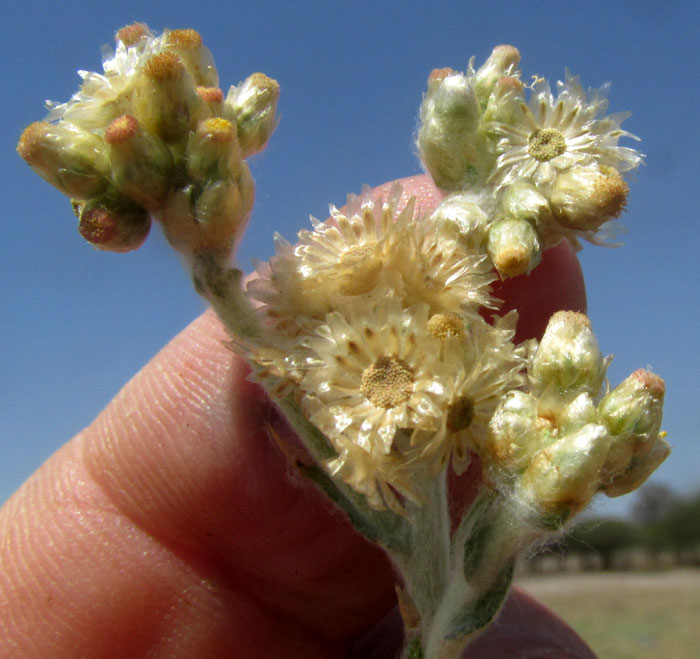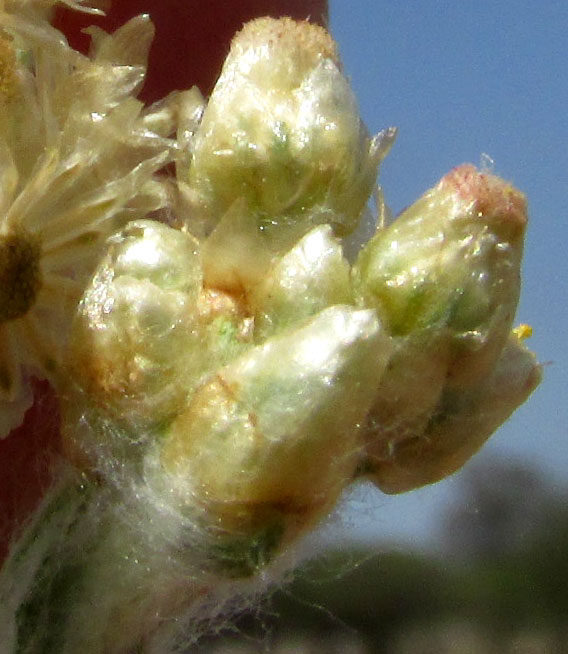Excerpts from Jim Conrad's
Naturalist Newsletter
entry dated April 28, 2023, issued from near Tequisquiapan, elevation about 1,900m (6200 ft), Querétaro state, MÉXICO
(~N20.55°, ~W99.89°)
CUDWEED

Now at the end of an especially rainless dry season, after last year's rainy season never developed normally, Tequisquiapan's large reservoir is completely dry, except for a narrow stream looking suspiciously like sudsy sewage. Nowadays the reservoir's flat, dry bed, normally submerged most or all of most years, is partially vegetated with weeds; It's interesting to see which species invade such a place. One species is shown above.
Students trying to identify this plant by keying it out using technical features will have a hard time. The flowers are so tiny that without considerable magnification basic features can't be analyzed. Here's a closer look at one of the above plant's heads:

In the above picture, each item looking like a little white, dried sunflower is what remains of a flowering head, or capitulum. Each capitulum originally contained up to 60 or more florets, with each floret producing a one-seeded, cypsela-type fruit. Already the capitula have matured, their fruits have been dispersed by wind, and nothing remains but empty, dried-out, flower-like platforms.
This arrangement of florets in flowering heads indicates a member of the largest and most diverse of all plant families, the Composite/Aster/Sunflower Family, the Asteraceae. To identify our plant just to genus level, using technical features, it's necessary to recognize, among other details, that florets in the center of each head bear functional stamens and pistil, while florets along the head's margin lack functional stamens. In the field, the unaided human eye can't see such minute but determinative features.
However, this group of plants, the cudweeds, is well known by those who pay attention to wildflowers. When you see a herbaceous member of the Aster Family with capitula bearing many tiny florets, of which none bear petal-like ray flowers, the stems bear single, slender leaves at each node, and the entire plant is densely mantled with white, often cobwebby hairs, it's easily recognizable as a kind of cudweed, sometimes called rabbit-tobacco. However, it still can be a challenge to determine the species, and even the genus. Obscure details must be noticed.

For example, most plants regarded as cudweeds or rabbit-tobaccos belong to either the genus Gnaphalium or the genus Pseudognaphalium. Species in the genera are somewhat similar. However, the above close-up of a tightly clustered head on our plant shows that the scale-like bracts, or phyllaries, forming a kind of bowl or urn around holding the many florets are all white; they're "monochromous phyllaries." It happens that in the big genus Gnaphalium, the phyllaries are "polychromous" -- display more than one color. That feature by itself disqualifies the 38 or so species of cudweed placed in Gnaphalium. Our plant is a Pseudognaphalium, of which about 100 species currently are recognized.

The above picture shows two critical features needed for recognizing the species. Where the leaf bases attach to the white-hairy stem, instead of the usual slender petiole, the blade margins form tiny lobes, or "ears." Second, leaf upper surfaces are slightly less hairy, thus greener, than the lower surfaces. That's more obvious below:

The picture above shows the plant's base, from which several vigorous sprouts arise.
All the above features and more -- including some not seen without magnification -- lead us to PSEUDOGNAPHALIUM LUTEOALBUM, a common weed throughout most of the world's warmer parts, except for most of South America.
from the January 28, 2008 issued from Yerba Buena Clinic just outside Pueblo Nuevo Solistahuacan, Chiapas, MÉXICO
about 1740 meters in elevation, ± LAT. 17° 11' 27"N, LONG. -92° 53' 35"W
CUDWEED THE FAT WOLF
Below, you can see a cudweed on a roadcut near my place.
Cudweeds are plain-looking members of the Composite or Sunflower Family, which means that their many tiny flowers are crammed together into flowerlike heads. One way to recognize cudweeds is by the white, cobwebby hairs mantling their bodies, and by their clumped-together flower heads lacking petal-like ray flowers. In the old days the cudweed species I dealt with were placed into the easy-to-recognize genus Gnaphalium but now Gnaphalium has been broken into smaller genera that only nit-picking taxonomists can appreciate.
No matter where I've traveled on Earth whenever I've seen cudweed -- and species occur practically worldwide -- I've always remembered the first time I came to Yerba Buena 25 or 30 years ago. At that time the clinic was operational and I was invited to participate in my first medical-service trip deep into the mountains to a village served by no roads, no electricity, no stores and certainly no medical attention. Burros carried supplies over narrow, muddy footpaths. It was my first time seeing just how impoverished and bad-off some of these backcountry settlements are.
I was assigned to hold people's heads as the clinic's dyslexic handyman pulled, levered and cut out rotten teeth, even after the Novocain ran out. Student nurses went hut to hut offering what help they could, mainly giving women advice on dealing with their pregnancies, but also counseling on treating tuberculosis, which infected a large portion of the adult population. A goodly number of people -- and not all were old -- were clearly coughing themselves to death.
For any and all respiratory problems, including TB cases, the student nurses prescribed gordolobo, a lobo gordo being a "fat wolf." Gordolobo is the name people here use for the plant I call cudweed. Weedy, overgrazed, eroding pastures surrounding such settlements always produce cudweed in abundance. For all chest ailments just go pick a cudweed bouquet, put it in boiling water, drink the tea, and hope for the best.
Maximino Martínez's Las Plantas Medicinales de México confirms cudweed/gordolobo's use for chest disorders, and expands its use to controlling coughing, and soothing sore throats. He prescribes making teas from the flowers but I've seen people use the whole plants. I've brewed the rather bland, yellowish teas both ways but can't say whether they work or not, since I've never had a cold in cudweed/gordolobo country.
With regard to the name cudweed, I wonder how many Americans these days even know what a cud is? Back on the farm in Kentucky "cud," which rhymes with "good," was a term as commonly used and homey-feeling as "worsh-house" and "fart." A cud is a wad of partially digested plant material brought up from a horse's or cow's first stomach when there's nothing else around to chew on. The critter stands around blankly staring at barn walls or fence posts as they chew on (ruminate) their cud until it's mashed up enough to swallow again and send to the second stomach. If you don't know about complex three- and four-chambered stomachs you may want to do a word search on "ruminant."
My tobacco-chewing kinfolk also used to carry "cuds" of tobacco in their coverall pockets. Fancier chewers called cuds "quids."